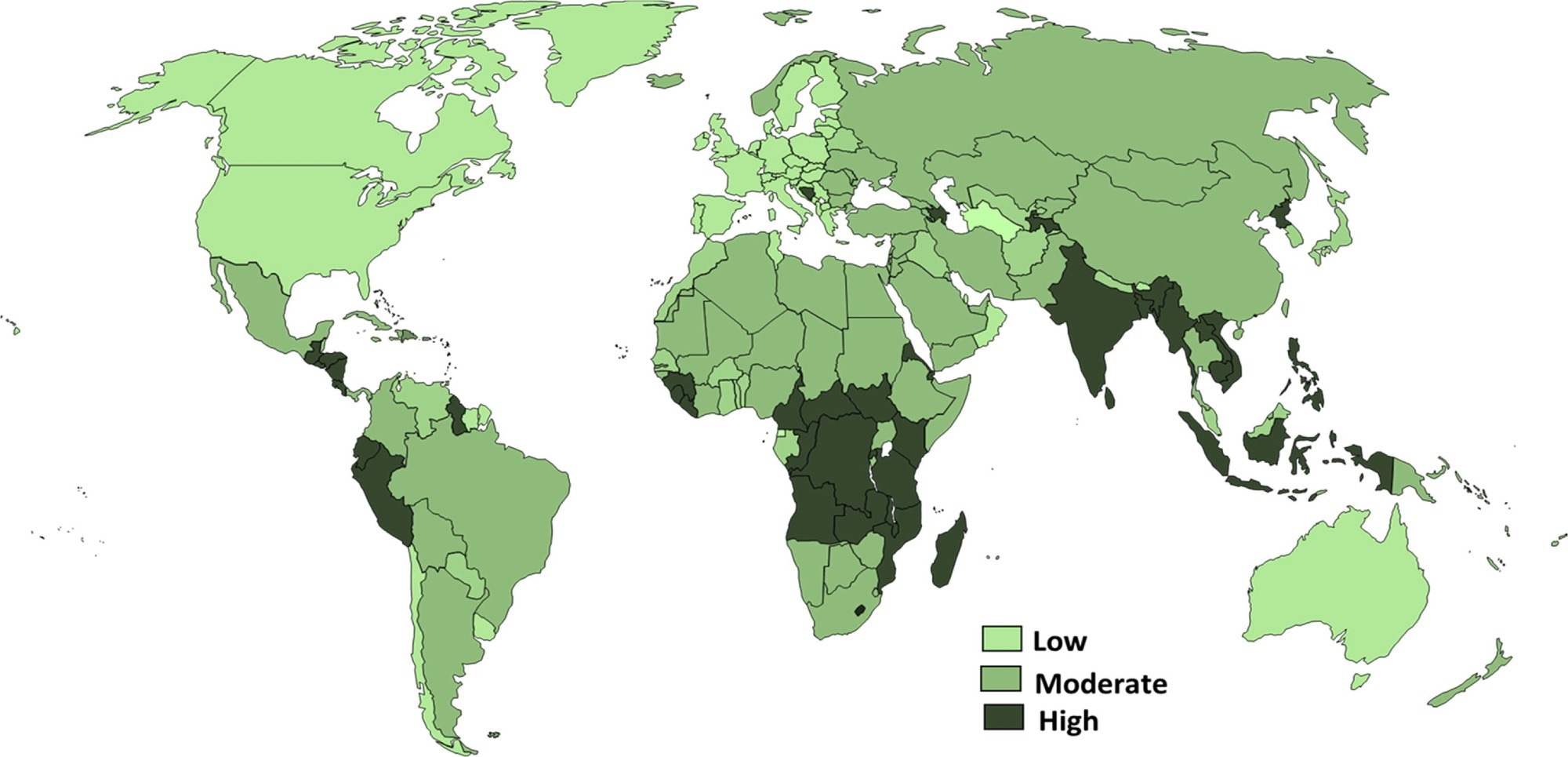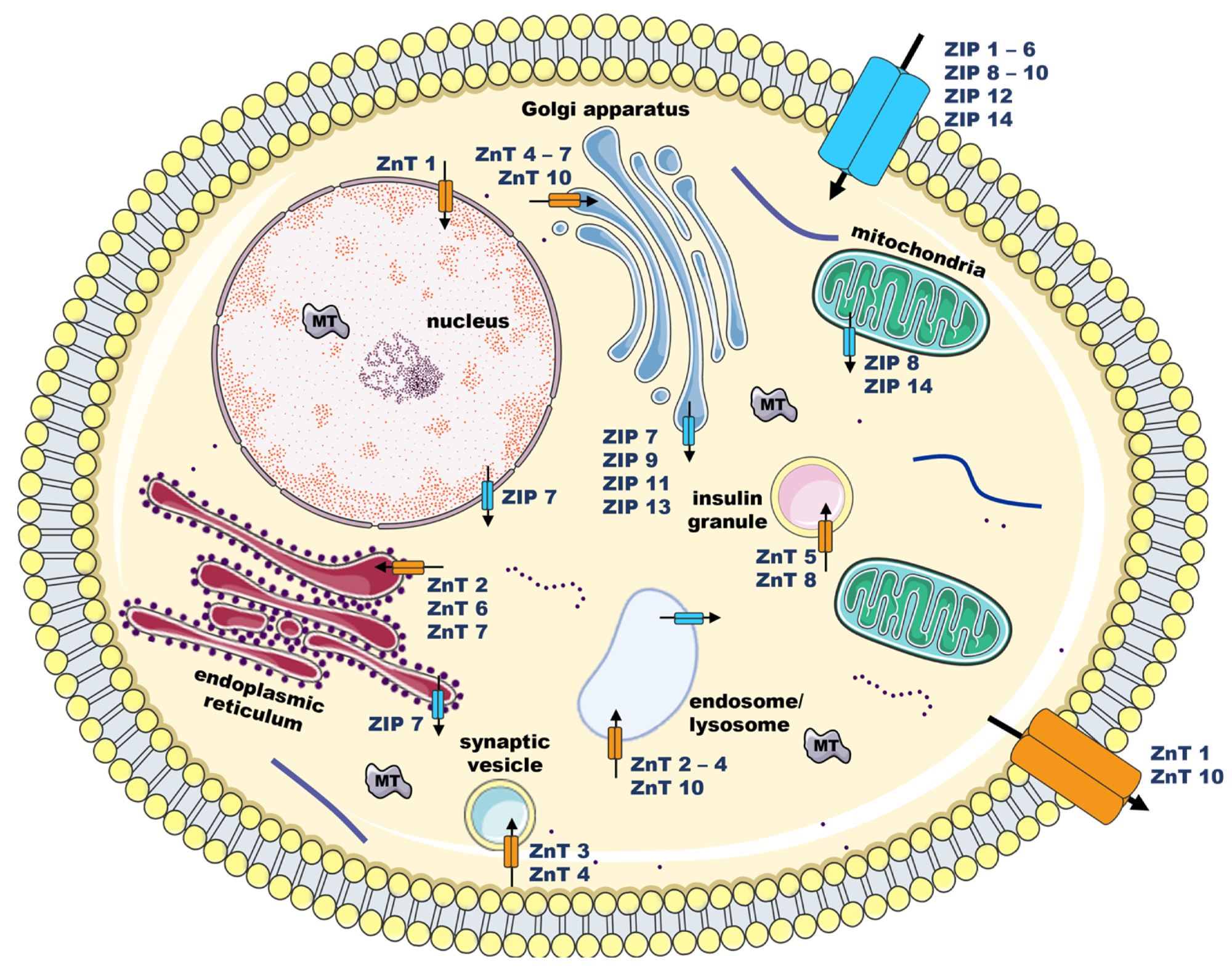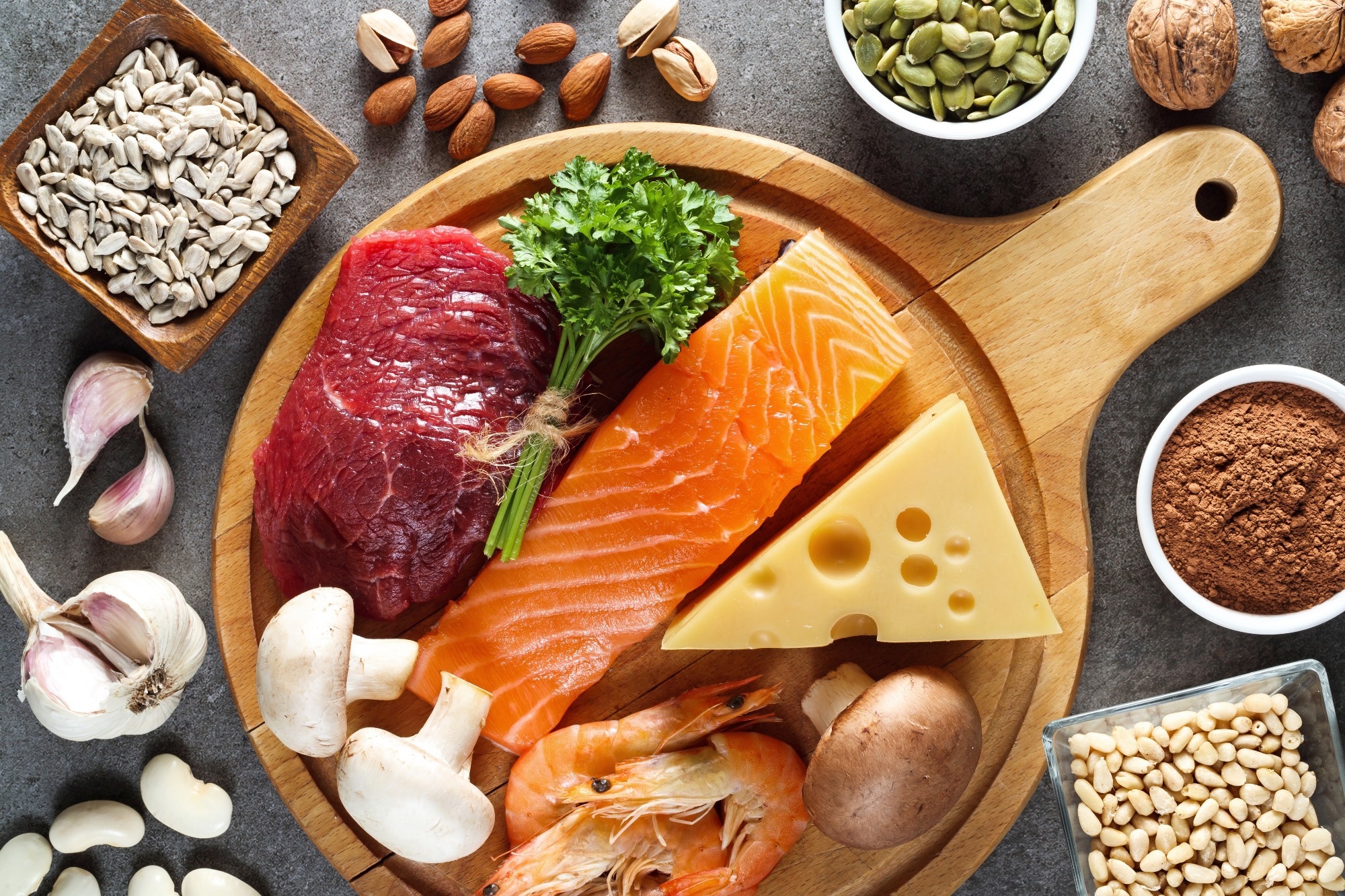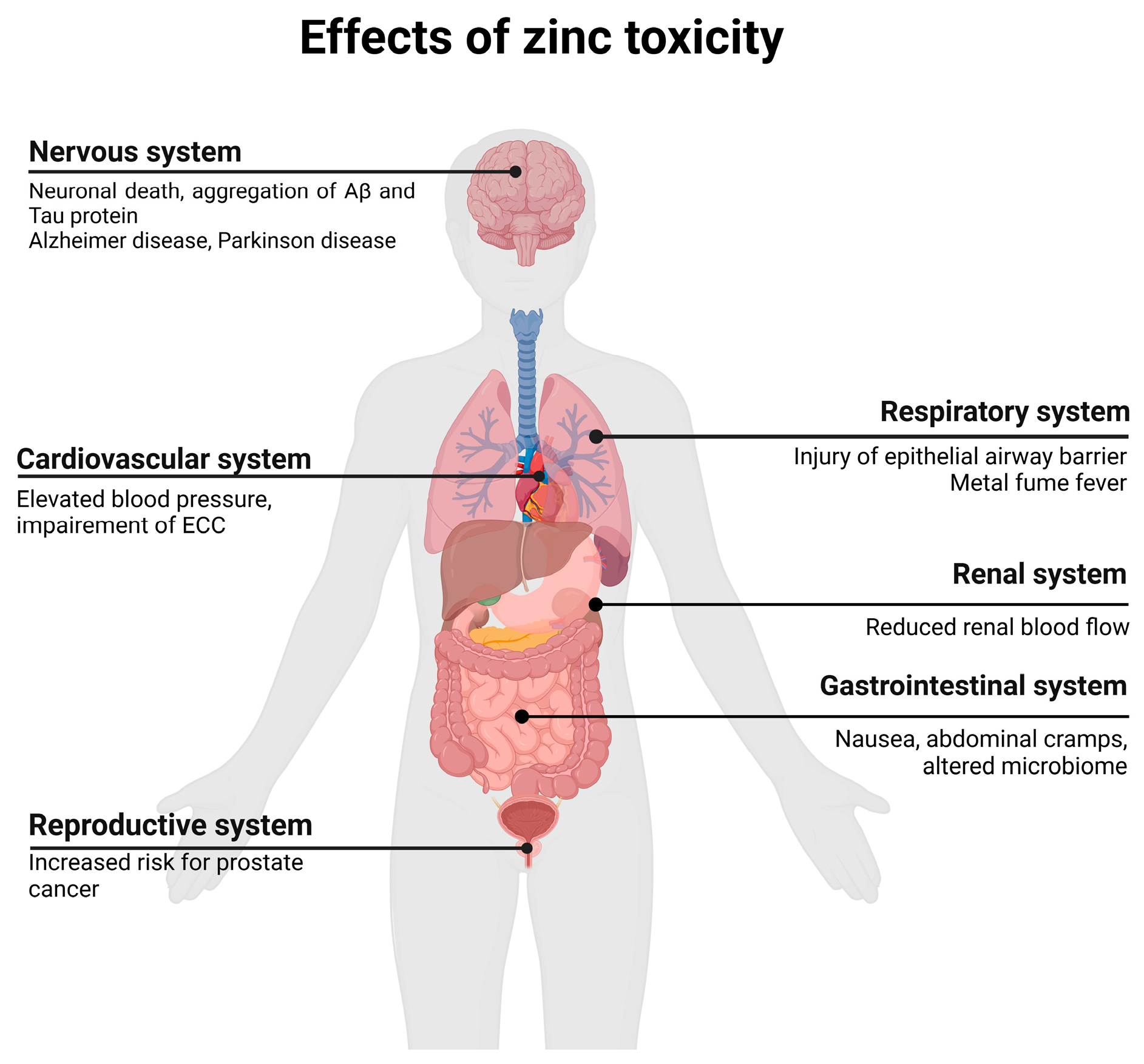Introduction
What is zinc?
Foods high in zinc
Zinc Content of Selected Foods
Health benefits of zinc
Recommended intake and deficiency risks
Safety and excess intake
Conclusions
References
Further reading
Zinc is an essential trace element that supports immunity, growth, and cellular repair. Adequate intake from food or supplementation helps prevent deficiency and promotes overall health.
 Image Credit: monticello / Shutterstock.com
Image Credit: monticello / Shutterstock.com
Introduction
Zinc plays a crucial role in maintaining physiological homeostasis, functioning as a catalytic and structural cofactor for hundreds of enzymes, regulating immune signaling, and safeguarding genomic stability. It also influences growth, neurological development, reproduction, and skin health, reflecting its broad physiological necessity. Because humans lack specialized zinc storage systems, a continuous dietary supply is required to sustain optimal zinc status.
Globally, inadequate zinc intake remains a significant public health challenge, particularly in populations that rely on high-phytate staple foods, which impair zinc absorption. To address this, strategies such as dietary diversification, food fortification, and supplementation are emphasized to reduce the risk of deficiency and improve health outcomes.
The following sections examine nutritional sources of zinc, its health benefits, recommended intake levels, risks of deficiency, and safety considerations, while highlighting practical approaches to optimize zinc nutrition across diverse populations.

The global prevalence of Zn deficiency. Nationwide Zn status based on inadequate dietary Zn and childhood growth stunting.6
What is zinc?
Zinc is an essential element that acts as a structural and catalytic cofactor for over 300 enzymes while stabilizing gene-regulating transcription factors, including zinc-finger proteins. As a signaling ion, zinc supports immune responses by modulating mitogen-activated protein kinase (MAPK) and phosphoinositide 3-kinase (PI3K)/protein kinase B (AKT) pathways, guiding cytokine production and cell survival.2
Zinc is a cofactor for poly(adenosine diphosphate-ribose) polymerase (PARP) and transcription factor tumor protein 53 (TP53), both of which detect damage and coordinate repair to preserve genomic integrity. In the skin, zinc supports keratinocyte proliferation, barrier formation, and wound healing while maintaining hydrogen (pH) balance through transporters that regulate intracellular zinc pools.2
Overall, zinc homeostasis plays a crucial role in maintaining immunity, promoting growth, and facilitating tissue repair. Thus, zinc deficiency compromises host defense, delays healing, and heightens vulnerability to cellular stress.1

Schematic illustration of zinc (Zn) homeostasis mechanisms and potential subcellular locations of Zn channels. Regulation of cellular zinc fluxes in and out of the cell and cellular compartments is controlled by several Zrt- and Irt-like proteins (ZIP; blue), the importers, and Zn transporters (ZnT; orange), the exporters. Metallothioneins (MT; grey) are also key proteins in Zn homeostasis; MT act as Zn buffers by binding to these ions and releasing them into the cytoplasm to increase free intracellular Zn pools, according to cellular needs. Arrows indicate the direction of Zn mobilization through Zn channels.2
Foods high in zinc
Zinc is abundant in animal-based foods and certain plants; however, its bioavailability varies. Animal sources of zinc include oysters, beef, pork, lamb, veal, poultry, dairy products, and eggs, with oysters being particularly rich in this element.1
Plant-based sources of zinc include nuts, seeds, dried legumes, and whole-grain cereals. Milling removes zinc-rich outer layers from grains, thereby lowering the zinc content of refined flours and breads.3
Across many diets, animal foods provide a large share of total zinc. Zinc-fortified breakfast cereals have also emerged as important sources, particularly for young children, with some studies reporting that zinc from high-phytate cereals is more readily absorbed when the cereals are fortified.3
Phytates in plant foods can inhibit zinc absorption; therefore, legumes and whole grains should be consumed with animal proteins or other promoters (e.g., amino acids, citrate) to improve zinc intake.1
 Image Credit: Evan Lorne / Shutterstock.com
Image Credit: Evan Lorne / Shutterstock.com
Zinc Content of Selected Foods
| Food |
Milligrams (mg) per
serving |
Percent
DV* |
| Oysters, Eastern, farmed, raw, 3 ounces |
32 |
291 |
| Oysters, Pacific, cooked, 3 ounces |
28.2 |
256 |
| Beef, bottom sirloin, roasted, 3 ounces |
3.8 |
35 |
| Blue crab, cooked, 3 ounces |
3.2 |
29 |
| Breakfast cereals, fortified with 25% of the DV for zinc, 1 serving |
2.8 |
25 |
| Cereals, oats, regular and quick, unenriched, cooked with water, 1 cup |
2.3 |
21 |
| Pumpkin seeds, roasted, 1 ounce |
2.2 |
20 |
| Pork, center loin (chops), bone in, broiled, 3 ounces |
1.9 |
17 |
| Turkey breast, meat only, roasted, 3 ounces |
1.5 |
14 |
| Cheese, cheddar, 1.5 ounces |
1.5 |
14 |
| Shrimp, cooked, 3 ounces |
1.4 |
13 |
| Lentils, boiled, ½ cup |
1.3 |
12 |
| Sardines, canned in oil, drained solids with bone, 3 ounces |
1.1 |
10 |
| Greek yogurt, plain, 6 ounces |
1.0 |
9 |
| Milk, 1% milkfat, 1 cup |
1.0 |
9 |
| Peanuts, dry roasted, 1 ounce |
0.8 |
7 |
| Rice, brown, long grain, cooked, ½ cup |
0.7 |
6 |
| Egg, large, 1 |
0.6 |
5 |
| Kidney beans, canned, ½ cup |
0.6 |
5 |
| Bread, whole wheat, 1 slice |
0.6 |
5 |
| Fish, salmon, cooked, 3 ounces |
0.5 |
5 |
| Broccoli, chopped, cooked, ½ cup |
0.4 |
4 |
| Rice, white, long grain, cooked, ½ cup |
0.3 |
3 |
| Bread, white, 1 slice |
0.2 |
2 |
| Cherry tomatoes, raw, ½ cup |
0.1 |
1 |
| Blueberries, raw, ½ cup |
0.1 |
1 |
What does %DV mean? % Daily Value (%DV) indicates the percentage of zinc a serving of food contributes toward the daily amount most adults need. For example, if a food has 20% DV zinc, it gives you about one-fifth of your daily zinc needs.
Health benefits of zinc
Zinc supports white blood cells, especially neutrophils, natural killer cells, as well as both T- and B-lymphocytes, in their development, signaling, and clearance of pathogens. Zinc also exhibits antiviral activity by modulating interferon-stimulated pathways and impairing viral replication directly in several viruses.4
Clinically, zinc supplementation can shorten the duration of the common cold when initiated soon after symptoms start. In fact, a recent systematic review of randomized trials in healthy adults found that zinc alone reduced cold duration by about 2.25 days.5
Zinc also contributes to skin health through its involvement in wound healing and tissue repair, which has led to the widespread use of topical or systemic zinc for dermatologic indications. In fact, clinical trials have reported the benefits of topical zinc for treating recurrent herpes and viral warts.4
Adequate zinc levels are necessary to achieve normal growth and development, preserve taste and smell perception, and maintain reproductive health, as zinc deficiency has been historically linked to hypogonadism and subfertility. Together, these benefits underscore the crucial role of zinc in immune resilience, skin repair, and overall well-being, particularly in older adults and other patient populations at a higher risk of zinc deficiency.4
Recommended intake and deficiency risks
Daily zinc requirements vary by age, sex, and life stage. Children generally require 1.5-6 mg/day, depending on their age. Public health entities, such as the World Health Organization (WHO), the International Zinc Nutrition Consultative Group, and the Institute of Medicine, provide age-specific targets.1
Zinc requirements increase in pregnancy to 7-13 mg/day to support fetal growth, with 11-14 mg/day of zinc needed during lactation to replace zinc secreted in breast milk. Recommendations vary across authorities and dietary phytate levels, with some regions setting higher targets when bioavailability is low.1 Adults are advised to meet sex- and age-specific recommended daily intakes. Dietary habits should also be considered, as individuals who consume more animal-based products typically provide more absorbable zinc than those on plant-based diets that are high in phytates.3
Common symptoms of zinc deficiency include impaired immune responses, delayed wound healing, dermatologic changes such as skin lesions and dermatitis. In severe cases of zinc deficiency, hair loss may also occur. These outcomes arise from zinc’s involvement in enzyme function, gene regulation, and keratinocyte migration during tissue repair.6
Vegetarians and populations consuming high-phytate staple diets are at a greater risk of zinc deficiency, as phytates reduce zinc absorption. Pregnant and lactating women, due to higher physiological needs, are also vulnerable.6
Due to the rapid growth that occurs during childhood, infants and children may also be at risk of zinc deficiency. Additional high-risk groups include older adults and individuals with malabsorption or increased losses.6
Thus, monitoring susceptible groups and considering diet diversification, fortification, or supplementation can prevent deficiency and its health impacts.6
The 7 Warning Signs of a Zinc Deficiency
Safety and excess intake
The European Food Safety Authority considers 25 mg/day to be the tolerable upper intake level (UL) of zinc for adults, whereas the United States authorities allow up to 40 mg/day.7 Intakes above these limits disrupt copper homeostasis by inducing intestinal metallothionein, which preferentially binds copper.7
Resulting copper deficiency can present with anemia, leukopenia, or neutropenia, as well as neurological symptoms. Case reports describe undetectable serum copper levels after supplemental intakes of around 65 mg/day, with recovery occurring after stopping zinc and replacing copper.7
Gastrointestinal intolerance is also common at high doses. Specifically, study volunteers taking 50 mg elemental zinc three times daily reported nausea, abdominal cramps, vomiting, and diarrhea, with similar effects reported among patients receiving zinc sulfate.7
Exposure to denture adhesive creams, which may contain substantial amounts of zinc, has caused copper deficiency when used excessively. Excessive zinc intake may also lead to immune suppression, as supraphysiologic zinc levels reduce T- and B-cell function and interferon-α responses.7

Overview of possible adverse effects and diseases of zinc toxicity. Adapted from “Human organs with Callout”, by BioRender.com (2024). Retrieved from https://app.biorender.com/biorender-templates, accessed on 25 June 2024. ECC, excitation–contraction coupling.7
Conclusions
Zinc is an essential element that can be found in a wide range of foods, including seafood, lean meats, dairy, legumes, nuts, seeds, and fortified cereals. Ensuring adequate zinc intake is crucial for maintaining a resilient immune system, promoting healthy skin function, and supporting overall systemic homeostasis.1
References
- Stiles, L. I., Ferrao, K. & Mehta, K. J. (2024). Role of zinc in health and disease. Clinical and Experimental Medicine 24. DOI:10.1007/s10238-024-01302-6, https://link.springer.com/article/10.1007/s10238-024-01302-6
- Costa, M. I., Sarmento-Ribeiro, A. B., & Gonçalves, A. C. (2023). Zinc: From Biological Functions to Therapeutic Potential. International Journal of Molecular Sciences 24(5). DOI:10.3390/ijms24054822, https://www.mdpi.com/1422-0067/24/5/4822
- Gibson, R. S. (2012). A historical review of progress in the assessment of dietary zinc intake as an indicator of population zinc status. Advances in Nutrition 3(6): 772-782. DOI:10.3945/an.112.002287, https://academic.oup.com/advances/article/3/6/772/4591460
- Read, S. A., Obeid, S., Ahlenstiel, C., & Ahlenstiel, G. (2019). The role of zinc in antiviral immunity. Advances in Nutrition 10(4): 696-710. DOI:10.1093/advances/nmz013, https://academic.oup.com/advances/article/10/4/696/5480856
- Wang, M. X., Win, S. S., & Pang, J. (2020). Zinc supplementation reduces common cold duration among healthy adults: a systematic review of randomized controlled trials with micronutrients supplementation. The American Journal of Tropical Medicine and Hygiene 103(1): 86-99. DOI:10.4269/ajtmh.19-0718, https://www.ajtmh.org/view/journals/tpmd/103/1/article-p86.xml
- Khan, S. T., Malik, A., Alwarthan, A., & Shaik, M. R. (2022). The enormity of the zinc deficiency problem and available solutions; an overview. Arabian Journal of Chemistry 15(3). DOI:10.1016/j.arabjc.2021.103668, https://www.sciencedirect.com/science/article/pii/S1878535221006833
- Schoofs, H., Schmit, J., & Rink, L. (2024). Zinc toxicity: understanding the limits. Molecules 29(13). DOI:10.3390/molecules29133130, https://www.mdpi.com/1420-3049/29/13/3130
Further Reading
Last Updated: Sep 29, 2025